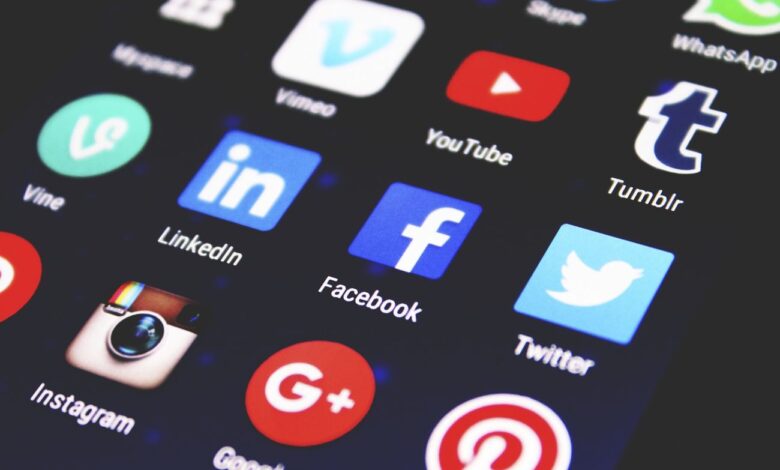
5 Biggest Social Media Platforms By Monthly Users
Social media encompasses interactive technologies that enable the formation and exchange of information, thoughts, hobbies, and various forms of expression within virtual communities and networks.
While the definition of social media can be complex due to the diverse range of standalone and integrated services available, there are some shared characteristics:
- Social media platforms are interactive applications based on Web 2.0 technology.
- The essence of social media lies in user-generated content, encompassing text posts, comments, digital photos or videos, and data generated through all online interactions.
- Users establish and maintain service-specific profiles on websites or apps, which are managed by the respective social media organizations.
- Social media helps in the formation of online social networks by linking a user’s profile with those of other individuals or groups.
However, have you ever wondered which are 5 biggest social media platforms that people use all over the world right now? You can probably guess most of them, but below I am going to mention five most active social media platforms by monthly users.
5. TikTok: 1.53 billion monthly users

TikTok, along with its Chinese version Douyin, is a video hosting social media service owned by ByteDance that it’s known for its short-video content. Users can submit videos of varying lengths, spanning from 3 seconds to 10 minutes.
Since their introduction, TikTok and Douyin have achieved widespread recognition across the globe. By October 2020, TikTok had exceeded 2 billion mobile downloads worldwide. Morning Consult acknowledged TikTok as the third-fastest growing brand in 2020, trailing only Zoom and Peacock. Additionally, Cloudflare ranked TikTok as the most visited website of 2021, surpassing google.com.
4. Instagram: 2 billion monthly users

Instagram, a social networking service owned by Meta Platforms, focuses on sharing photos and videos. Users can upload media, apply filters, and organize them using hashtags and geotags. Posts can be shared publicly or with approved followers. Users have the ability to explore other users’ content by tags and locations, engage with photos by liking them, and follow other users to view their content on a personalized feed.
Initially, Instagram stood out by allowing content to be displayed in a square (1:1) aspect ratio of 640 pixels, aligning with the iPhone’s display width at that time. However, in 2015, this restriction was relaxed, allowing for an increase to 1080 pixels. The platform also introduced messaging features, the option to include multiple images or videos in a single post, and a Stories feature, similar to its competitor Snapchat. The Stories feature enables users to share content that remains accessible for 24 hours in a sequential feed. As of January 2019, 500 million people use Stories daily.
Instagram was first launched for iOS in October 2010 by Kevin Systrom and Mike Krieger. It quickly gained popularity, accumulating one million registered users within two months, 10 million in a year, and reaching one billion by June 2018. In April 2012, Facebook Inc. acquired the service for approximately US$1 billion. Instagram subsequently expanded its availability, releasing an Android version in April 2012, a limited desktop interface in November 2012, a Fire OS app in June 2014, and a Windows 10 app in October 2016. By October 2015, over 40 billion photos had been uploaded to the platform.
Despite its success and influence, Instagram has faced criticism for its potential negative impact on the mental health of teenagers, policy and interface changes, allegations of censorship, and the presence of illegal and inappropriate content uploaded by users.
3. WhatsApp: 2.24 billion monthly users

WhatsApp is a widely used instant messaging and voice-over-IP service available across countries. It operates as freeware and is compatible with multiple platforms, enabling users to communicate seamlessly. This centralized service is owned by Meta, a prominent US technology conglomerate. WhatsApp offers various features such as text and voice messaging, voice and video calls, and the ability to share images, documents, user locations, and other forms of content. Its mobile client application can be accessed not only on mobile devices but also on computers, providing flexibility in communication. To sign up for the service, users need a cellular mobile telephone number. In January 2018, WhatsApp introduced a separate app called WhatsApp Business, designed specifically for business purposes and allowing communication with the standard WhatsApp client.
Initially developed by WhatsApp Inc., a company based in Mountain View, California, the service caught the attention of Facebook, which acquired it in February 2014 for a substantial amount of approximately US$19.3 billion. By 2015, WhatsApp had become the most popular messaging application globally, and its user base surpassed 2 billion worldwide by February 2020. In regions such as Latin America, the Indian subcontinent, and significant parts of Europe and Africa, it had become the primary means of internet communication by 2016.
2. YouTube: 2.56 billion monthly users

YouTube, an online video sharing and social media platform headquartered in San Bruno, California, United States, is a prominent entity in the digital realm. Launched on February 14, 2005, by Steve Chen, Chad Hurley, and Jawed Karim, YouTube has established itself as a global phenomenon. It is now owned by Google and holds the distinction of being the second most visited website worldwide, right after Facebook. With over 2.5 billion monthly users, YouTube boasts a staggering statistic: users collectively watch more than one billion hours of videos every single day. In fact, as of May 2019, the platform witnessed the upload of content at an astonishing rate of over 500 hours per minute.
Google’s acquisition of YouTube in October 2006 for $1.65 billion marked a pivotal moment for the platform. Under Google’s ownership, YouTube expanded its business model beyond advertising revenue and ventured into offering paid content, including movies and exclusive content produced by YouTube itself. The platform introduced YouTube Premium, a subscription option that allows users to enjoy content without intrusive ads. Additionally, YouTube facilitated creators’ participation in Google’s AdSense program, which aims to generate increased revenue for both creators and the platform. Notably, YouTube reported a revenue of $29.2 billion in 2022, and its annual advertising revenue reached $28.8 billion in 2021, showcasing significant growth.
Since being acquired by Google, YouTube has undergone remarkable expansion, branching out from its core website to encompass mobile apps, network television integration, and seamless integration with other platforms. The platform offers a diverse range of video categories, including music videos, video clips, news, short films, feature films, songs, documentaries, movie trailers, teasers, live streams, vlogs, and much more. While individual content creators contribute a significant portion of the content, collaborations between YouTubers and corporate sponsors are also prevalent. Esteemed media corporations like Disney, Paramount, NBCUniversal, and Warner Bros. Discovery have recognized the potential of YouTube’s wide-reaching audience and have established and expanded their own corporate YouTube channels.
YouTube’s influence on popular culture and its ability to shape internet trends cannot be understated. The platform has catapulted numerous individuals into the realm of multimillionaire celebrities. However, alongside its remarkable growth and success, YouTube has faced substantial criticism. Allegations of facilitating the spread of misinformation and unauthorized sharing of copyrighted content, concerns over privacy violations, issues surrounding censorship, and the safety and well-being of children have been among the criticisms directed at the platform. The guidelines and their implementation have also been subject to scrutiny.
In summary, YouTube’s history is marked by its rise as a dominant online video platform, its integration with Google, its immense popularity, and its impact on society. While it has faced criticism and challenges, YouTube remains a prominent force in the digital landscape.
1. Facebook: 2.99 billion monthly users
Facebook, an online social media and networking service, falls under the ownership of Meta Platforms, a prominent American technology giant. It was founded in 2004 by Mark Zuckerberg alongside his Harvard College colleagues and roommates Eduardo Saverin, Andrew McCollum, Dustin Moskovitz, and Chris Hughes. The platform’s name was inspired by the traditional face book directories that were commonly distributed among American university students. Initially, Facebook membership was restricted to Harvard students but gradually expanded to include other North American universities. Since 2006, the platform has been accessible to anyone over the age of 13. As of December 2022, Facebook boasted an impressive 2.96 billion monthly active users and ranked as the third most visited website worldwide. Additionally, it secured the title of the most downloaded mobile app of the 2010s.
Facebook can be accessed through various devices with internet connectivity, such as personal computers, tablets, and smartphones. Upon registration, users have the ability to create a profile and share information about themselves. They can post text, photos, and multimedia content that can be shared with other users who have accepted their friend requests or, with varying privacy settings, made publicly accessible. Users can also communicate directly with each other using the Messenger feature, join groups based on common interests, and receive notifications about the activities of their Facebook friends and followed pages.
Facebook has been at the center of numerous controversies throughout its existence. It has faced criticism for issues such as user privacy, exemplified by the Cambridge Analytica data scandal, as well as allegations of political manipulation during the 2016 U.S. elections and concerns related to mass surveillance. The platform has also faced scrutiny regarding psychological effects such as addiction and low self-esteem, and has been embroiled in controversies surrounding content including fake news, conspiracy theories, copyright infringement, and hate speech. Some commentators have accused Facebook of knowingly facilitating the spread of such content, as well as inflating its user numbers to attract advertisers.
In summary, Facebook’s history is characterized by its origins as a platform for university students, its exponential growth into a global social media giant, and its role in various controversies. While it has revolutionized online connectivity, the platform has been the subject of significant scrutiny and criticism related to privacy, politics, content, and psychological impact.





